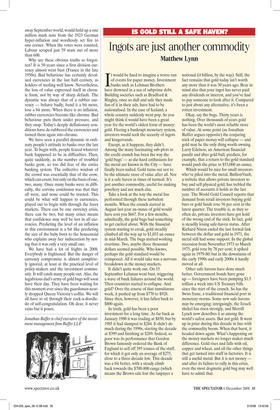Ingots are just another commodity
Matthew Lynn
It would be hard to imagine a worse run of events for paper money. Investment banks such as Lehman Brothers have drowned in a sea of subprime debt. Building societies such as Bradford & Bingley, once so dull and safe they made fun of it in their ads, have had to be nationalised. In the case of Iceland, a whole country suddenly went pop. So you might think it would have been a great year for the world’s oldest form of money: gold. Fleeing a bankrupt monetary system, investors would seek the security of ingots and krugerrands.
Except, as it happens, they didn’t. Among the many fascinating sub-plots to the credit crunch has been the way the ‘gold bugs’ — as die-hard enthusiasts for the metal are known in the City — have finally been nailed. Gold turns out not to be the ultimate store of value after all. Nor is it a safe haven in times of turmoil. It’s just another commodity, useful for making jewellery and not much else.
Take a look at the way the metal has performed through these turbulent months. When the crunch started in August last year an ounce of gold would have cost you $667. For a few months, admittedly, the gold bugs had something to get excited about. With the financial system starting to creak, gold steadily climbed all the way up to $1,033 an ounce in mid-March. The bugs started working overtime. Two, maybe three thousand dollars seemed possible. Who knows, perhaps the gold standard would be reimposed. All it would take was a nervous breakdown in the money markets.
It didn’t quite work out. On 15 September Lehman went bust, triggering a wave of bank failures around the world. Then countries started to collapse. And gold? Over the course of that tumultuous week, it pushed up from $770 to $928. Since then, however, it has fallen back to $800 again.
In truth, gold has been a poor investment for a long time. As far back as January 1980 it was trading at $850, but by 1985 it had slumped to $284. It didn’t do much during the 1990s, starting the decade at $399 and finishing at $289. Indeed, so poor was its performance that Gordon Brown famously ordered the Bank of England to sell off 395 tonnes of the stuff, for which it got only an average of $275, close to a three-decade low. This decade was a bit better, with a steady climb back towards the $700-800 range (which means the Brown sale lost the taxpayer a notional £4 billion, by the way). Still, the fact remains that gold today isn’t worth any more than it was 30 years ago. Bear in mind also that your ingot has never paid any dividends or interest, and you’ve had to pay someone to look after it. Compared to just about any alternative, it’s been a rotten investment.
Okay, say the bugs. Thirty years is nothing. Over thousands of years gold has been the world’s most reliable store of value. At some point (as Jonathan Ruffer argues opposite) the conjuring trick of paper money will collapse — and gold may be the only thing worth owning. Larry Edelson, an American financial pundit and fiber gold bull, predicts, for example, that a return to the gold standard would push the price to $53,000 an ounce.
Which would be nice for small investors who’ve piled into the metal. BullionVault, a website that allows private investors to buy and sell physical gold, has trebled the number of accounts it holds in the last year. The World Gold Council reports that demand from retail investors buying gold bars or gold funds rose 56 per cent in the latest quarter. The trouble is, as they so often do, private investors have got hold of the wrong end of the stick. In fact, gold is steadily losing safe-haven status. After Richard Nixon ended the last formal link between the dollar and gold in 1971, the metal still had some support. In the global recession from November 1973 to March 1975, gold rose by 78 per cent; it spiked again in 1979-80; but in the downturns of the early 1990s and early 2000s it hardly moved at all.
Other safe havens have done much better. Government bonds have gone up — foreigners have been pumping $1.5 trillion a week into US Treasury bills since the start of the crunch. So has the Swiss franc, a traditional financial port in monetary storms. Some new safe havens may be emerging: intriguingly, the Israeli shekel has risen strongly, and Merrill Lynch now describes it as among the world’s safest assets. But not gold. It went up in price during this decade in line with the commodity boom. When that burst, it headed down again. What’s happening on the money markets no longer makes much difference. Gold rises and falls with oil, copper and wheat, and all the other things that get turned into stuff in factories. It is still a useful metal. But it is not money — and after its failure to rally in this crisis, even the most dogmatic gold bug may well have to admit that.


















































































 Previous page
Previous page